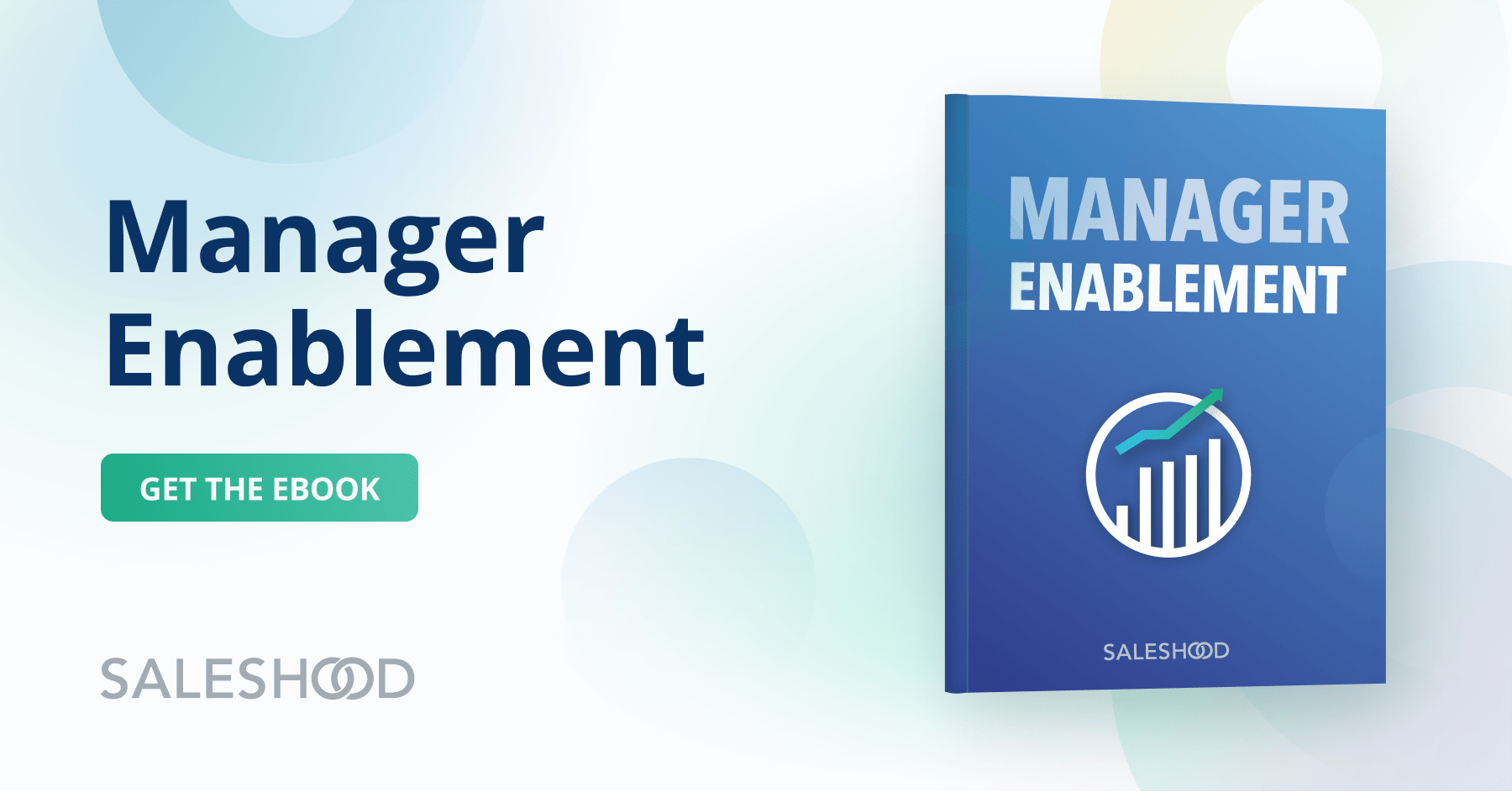Sales coaching is one of the most essential tools for helping to improve sales performance. According to Forrester’s research, 63% of sellers say that the feedback and coaching they receive help improve their performance. Gartner’s State of Sales Manager Coaching report shows effective coaching from sales managers can unlock an 8% improvement in sales performance.
In recent years many organizations have shifted to a remote-first or hybrid work scenario. Do you know how remote work is impacting sales performance and sales coaching? The time to take a closer look is now. If you don’t have the right processes in place, this ongoing trend has the power to stand in the way of the revenue goals your organization is striving to achieve.
Here’s a closer look at the value of data-driven sales coaching and how to implement it in a modern, increasingly remote enablement landscape.
What is sales coaching?
Providing regular sales coaching is essential because it helps salespeople identify areas for improvement and develop strategies to reach sales goals.
However, sales coaching remotely presents an information gap because less information is available to all parties. There are fewer signals for managers and team members to rely on. One of the biggest challenges is that remote coaching lacks the benefits of in-person communication, including the ability to read body language and nonverbal cues.
The virtual environment can also make it easier for people to be distracted, with competing priorities and digital interruptions vying for their attention. As a result, managers may miss crucial information during virtual coaching sessions that could help them identify areas for improvement. The sales team members being trained may also have trouble taking in the information they need.
To fully leverage the benefits of sales coaching, it’s crucial to understand and address these gaps. That’s what will lead to a positive impact on pipeline and revenue.
Strategies for Successful Sales Coaching
Sales managers can close the gap by leveraging data to make informed coaching decisions. You can use these strategies to bridge that gap and implement a data-driven sales coaching strategy.
Sales coaching strategy #1: Put in the prep work before sales coaching.
Any productive meeting or conversation starts with clear talking points and goals. This is where a 1:1 prep sheet can help. It’s important for managers to know
- What is my new hire doing from an onboarding perspective
- How is their Salesforce perspective, how is their hygiene
- How is their quota attainment and performance perspective
Managers can’t spend time on everything, so they have to prioritize their time and topics. So, drilling down into the agenda to prepare really helps managers have a purpose statement for 1:1 meetings.
Sales coaching strategy #2: Understand personal motivations of your teams.
Showing our appreciation is something effective front-line sales managers make a habit out of to boost morale, but are you doing it in the most effective way? Knowing languages of appreciation in the workplace is key to fostering a positive work environment. Some may appreciate acts of service while others are more interested in gifts or quality time. It’s important to know who will respond best to these different gestures.
Remind your front-line managers to understand the motivations and personal drivers of their team members. What hobbies to they have? What are their passions? What’s their family situation? Have your managers be thoughtful about what’s important to their team members when developing a sales coaching plan and recognition and rewards.
Sales coaching strategy #3: Recognize accomplishments and success milestones.
Once you have the information, putting what you know about each sales team member’s appreciation style into action helps to build strong relationships and keep remote workers engaged. Here are some ways to communicate appreciation:
- Send thoughtful physical notes or gifts to surprise sales reps when they’re making progress
- Give praise in ways that others can see it too, such as copying them on a praise email or giving compliments during conference calls
- Schedule a call occasionally just to chat and catch up and give them your undivided attention
- Help sellers on a deal or task or make sure they have all the resources they need to complete tasks efficiently
- Take advantage of the opportunity to meet if they ever are present in person
By showing appreciation through these actions sales managers can improve the success of remote sales training and boost morale. It’s a win-win.
Sales coaching strategy #4: Combine the art of sales coaching with the science of data.
Once you put the right steps in place to connect with sales team members, you can start putting metrics in place. Quantitative data can help guide coaching decisions and provide actionable feedback to team members.
Then, this feedback can be personalized to individual team members’ strengths and weaknesses, leading to improved sales performance and better overall sales outcomes. Your data can also help to identify coaching opportunities at scale, allowing sales managers to focus on the areas where they can have the most impact.
Not sure where to begin with putting all the pieces in place? You can start every new hire off on the right foot by keeping a close eye on sales performance and having a plan in place for coaching.
How to Increase Sales Success in the Ramp-Up Period
The success of a new sales hire is critical to the overall success of a sales organization. That’s why it’s important for sales leaders to have a comprehensive view of new hire performance during their ramp-up period. One tool that can provide this view is the new hire dashboard.
The new hire dashboard is a data visualization tool that provides a comprehensive look at the success of a sales new hire during their ramp-up period. The dashboard displays metrics and data points that help sales managers track the progress of new hires, identify areas of improvement, and adjust sales coaching strategies as needed.
What exactly does the dashboard show?
Sales Onboarding Participation: This metric measures the percentage of training modules completed and attendance at live training events. Sales onboarding is critical for new hires to get up to speed quickly and start contributing to the sales team’s success. Companies use SalesHood’s platform to track learning paths, training modules, and live training event attendance.
Role-Based Activity & Outputs: Criteria chosen according to the respective roles. This can include metrics such as the number of calls made, the number of demos conducted, and the number of meetings scheduled. For activities and output metrics, the company used its CRM, Salesforce. These metrics help to ensure that new hires are engaging in the right activities to drive success in their roles.
Sales Quota Attainment: Quantitative data that shows performance in relation to target goals. Quota attainment is essential to the success of the sales team, and it’s important to track how new hires are progressing toward their quotas during their ramp-up period. The company pulled this data together from Xactly before pulling everything together for visualization in Tableau.
Resources, Reactions, and Results With Data-Led Sales Coaching
You can put the work into creating these resources for sales coaching, but they can only be helpful if sales leaders know how to put them to use. Here’s how to ease the implementation of your efforts to coach with data.
Navigation Guide
The navigation guide should outline how to open dashboards and locate the specific data needed to support their sales activities. It should also include instructions on how to manipulate and filter data to see the most important information. A comprehensive navigation guide can help minimize the learning curve and increase the effectiveness of sales enablement coaching programs.
FAQs
Implementing a sales enablement coaching program can be challenging, but a comprehensive FAQ sheet can quickly address common questions and minimize delays. Take the time to provide details that will help troubleshoot technical issues and give an explanation of the metrics that matter.
Sales Coaching Playbook
Ensure that your sales leaders have best practices for coaching with data, such as conversation ideas and methods to identify areas of opportunity. Show how data can support coaching, help measure progress, and establish targeted areas of improvement. By incorporating these key elements into a sales coaching playbook, your sales team will be empowered to support growth and development.
The impact of this can be far-reaching, as Caitlin Lambert, Vertical Sales Onboarding Specialist at RingCentral explains. “It wasn’t enough just to come up with the numbers, we had to set our coaches and our teams up for the most success by supporting that data with concrete methods of utilization. And eventually, we’ll be able to establish a baseline glide path of average new hire ramp time that can be used to compare others’ successes during the program. At the same time, it also gives us a data-driven point of assessment for our sales training and onboarding program itself.”
Boost the Productivity of Your Sales Team With Modern Learning, Coaching, and Selling
If you want to take the next step and learn how to enable your teams with modern sales training, sales coaching, and content management, talk to a SalesHood sales enablement expert. SalesHood powers fast-growing companies with our purpose-built, all-in-one sales enablement platform by activating revenue teams to improve sales effectiveness and sales efficiency.
Get more sales enablement insights by reading one of these blog posts:
Sales Enablement KPIs: How to WOW the C-Suite
What Is Sales Enablement? A Complete Guide to Getting it Right
Creating a High-Impact Sales Enablement Program



